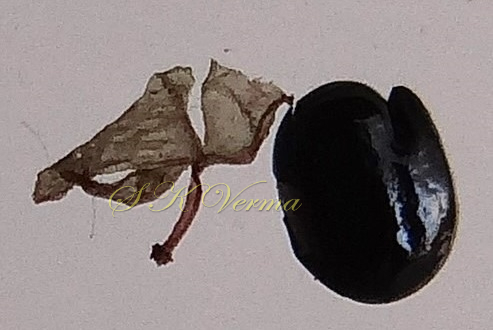PUPALIA
Pupalia
Juss., Ann. Mus. Natl. Hist. Paris. 2: 132. 1803; Boiss., Fl. Or. 4: 995; 1879; Hook. f., Fl. Brit. India 4: 723. 1885; Schinz in Engler & Prantl., Pflanzenfam. ed. 2, 16c: 47. 1934; Fl. Pak. @ eFloras.org p. 23.
Annual or perennial herbs or subshrubs with entire, opposite leaves. Inflorescence a spiciform bracteate thyrse, terminal on stem and branches, each bract subtending a clusters of 3 bisexual flowers: the outer flower 2-bracteolate bearing on the outer sides a pair of bracteolate, modified-flowers consisting of a number of sharply hooked spines, or each bract subtending a solitary 2-bracteolate, bisexual flowers subtended by 2 such modified flowers; bracteoles and spines of modified flowers at first very small, but rapidly accrescent; the spines finally set in 3 stalked clusters of mostly 5-10 spines on a common peduncle, much exceeding the perianth and serving as a means of distributing the fruit. Bracts persistent, finally +/- deflexed, perianth falling with the fruit. Perianth segments 5. Stamens 5, filaments fused at base into a fleshy, lobed, disc-like cup into which the base of ovary is narrowed; pseudostaminodes absent. Ovary unilocular with a single pendulous ovule; style slender; stigma capitate. Fruit a thin-walled utricle, irregularly ruptured below the middle by the developing seed. Seed ovoid, slightly compressed.
4 species
Pupalia lappacea
Pupalia lappacea
(L.) Juss., Ann. Mus. Natl. Hist. Paris. 2: 132. 1803; Boiss., Fl. Or. 4: 995. 1879; Hook. f., Fl. Brit. India 4: 723. 1885; Maheshwari, Illustr. Fl. Delhi f. 184. 1966; Nair, Fl. Bashahr Himal. 236. 1977; Townsend, Kew Bull. 34: 135. 1979; Kaur & Sharma, Fl. Sirmaur 543. 2004; Singh & Sharma, Fl. Chamba Dist. 596. 2006; Fl. Pak. @ eFloras.org p. 24; Achyranthes lappacea L., Sp. Pl. 204. 1753; Pupalia atropurpurea (Lam.) Moq. in DC., Prodr. 13(2): 331. 1849; P. lappacea var. velutina Hook. f., Fl. Brit. Ind. 4: 724. 1885.
Suberect or straggling perennial herb, grey-pubescent or tomentose, up to 1 m tall. Stem 4- angled to terete, swollen at nodes, densely tomentose. Leaves opposite; petiole 5-10 mm long, tomentose; lamina narrowly ovate-elliptic to ovate, 2-9 cm x 2-5 cm, acute, narrowed to a petiole, 0.5-1.0 cm long, both surfaces appressed-pubescent. Spikes terminal on stem and branches, at first +/- dense, elongating to up to 30 cm in fruit with the lower flowers becoming increasingly remote, axis tomentose; peduncle up to 6 cm long. Flowers in densely woolly, sessile or shortly stalked, close or distant, 5-6 mm long clusters borne on spike in axils of bracts; each cluster having 3 bisexual flowers, each of the two outer flowers bearing on outer side a pair of modified flowers (uppermost clusters may be with solitary bisexual flower and a pair of modified flowers). Bracts ca. 4 mm long, deltoid-lanceolate or ovate, persistent, +/- deflexed after the fall of fruit, pilose, sharply mucronate with percurrent midrib; bracteoles broadly cordate-ovate, ca 5 mm x 3.5 mm., conspicuous, sharply mucronate with excurrent midrib. Tepals 5, 4.5-6 mm long, oblong or lanceolate, densely woolly, 3(-5)-nerved, the lateral nerves of the 2 outer tepals strong throughout, joining the shortly excurrent midrib just below the apex. Spines of modified flowers are hooked distally, glabrous; spines in 3 shortly stalked clusters of 5-10 spines on a common peduncle, yellowish to purple, 3-4 mm. Stamens 5, purplish-red; filaments fused at base to form a fleshy, lobed, disc-like cup, filaments subulate, ca. 1.5 mm long; anthers ca. 0.8-0.9 mm long, oblong, dorsifixed. Pseudostaminodes absent. Ovary ca. 0.7 mm long with a single pendulous ovule; style slender, 1.25-1.5 mm long; stigma capitate. Capsule ovoid, 2-2.5 mm, compressed. Seed oblong-ovoid, ca. 2 mm x 1.7 mm, dark brown or brown black, shining. 3-flowered clusters fall together to form a “burr”, up to ca. 1.3 cm in diameter.
Common Names: Forest Burr, Creeping Cock’s Comb; Naga-daminee (Hindi)
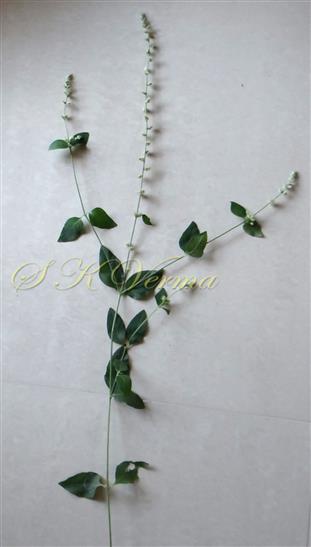
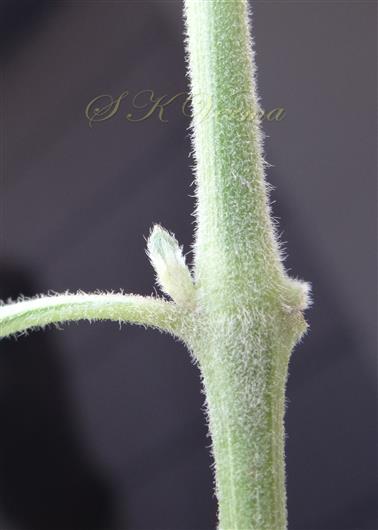
-DSC03850.jpg)
-DSC03851.jpg)



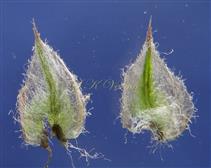
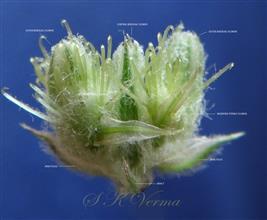

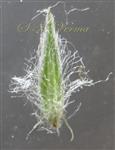
 flowers-DSC03859.jpg)
 flower-DSC03888.jpg)
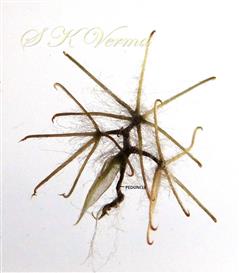
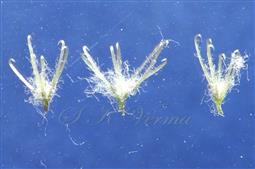
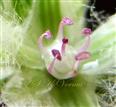
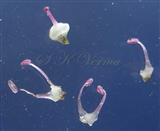

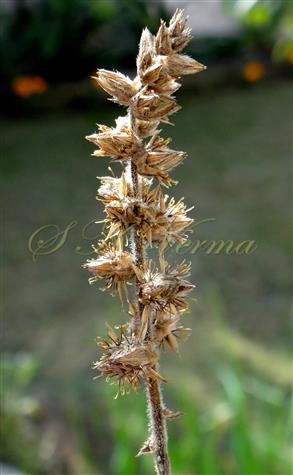
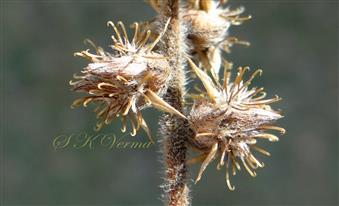




-DSC03850.jpg)
-DSC03851.jpg)


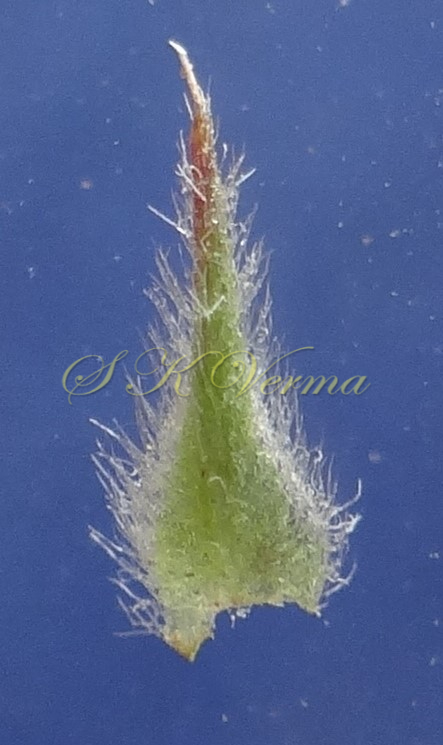




 flowers-DSC03859.jpg)
 flower-DSC03888.jpg)







